Garden Office Cost
Last updated 28th May, 2025
Since the pandemic, working from home has become more common. People now tend to either work from home on a full-time basis or work with a hybrid contract, which means they are at home apart from a set number of days in the month when they travel to work.
A garden office or a garden office pod is the perfect solution to the problem of separating home from work and being able to get your work done without too many distractions. It’s also a much cheaper way of creating the space you need without having to move house.
You can expect to pay between £12,000 and £20,000 for a modular unit. If you want a bespoke garden office, the average prices for a tailor-made option are between £30,000 and £40,000, depending on the range you choose.
If you’re on a budget and you already have a shed in the garden, you could convert the shed into a garden office if it is in good condition. Costs will depend on the quality of the materials you choose, but you should expect to pay between £5,000 and £7,000 for a shed conversion.
Let’s Make a Start…
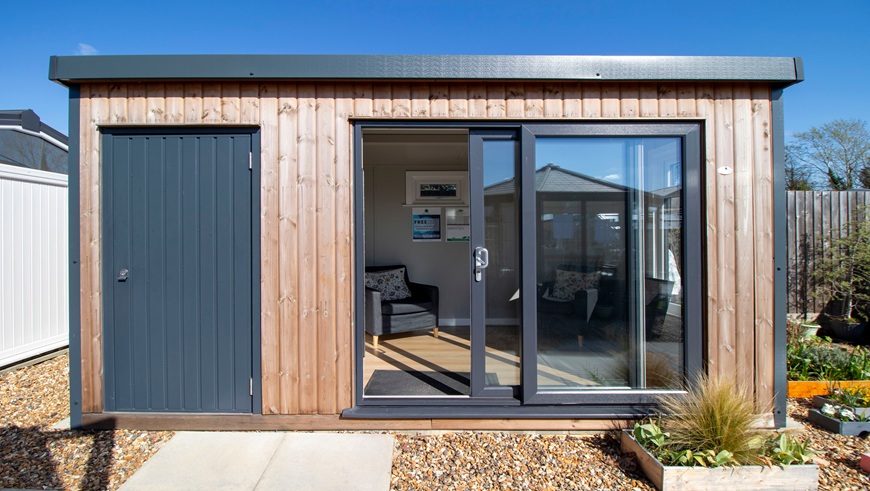
Table of Contents
How Much Does a Garden Office Cost?
Before you buy your garden office, you’ll need to set your budget. These are the factors that will affect the cost:
Size
The size of your garden office will influence the price. A small unit will cost less than a larger one because fewer materials are used in the build. However, the installation of electricity and an internet connection may well be the same, no matter what size garden office you have installed.
For example, a basic softwood home office that comes flat-packed will cost around £2,600 from a DIY/Garden Centre that’s 2.5 x 2.5. If you want a larger garden office (5m x 4m) from the same shop made out of the same material, you should expect to pay around £4,850, which is a price difference of £2,250.
Be careful, though, if you want an office for all year round, it is best not to buy a unit that’s advertised as a summerhouse. Summerhouses tend not to be insulated, which means they will be cold during the winter months. Look out for materials that are insulated or can be insulated.
Construction Method
If you plan to install your garden office as a DIY project, then you’ll pay less than if you hire a professional installer or buy a modular or bespoke unit. For example, if you spend £14,000 or more on a modular unit, it will possibly come with insulation, lighting, switches, guttering and heating with installation included.
If you buy a flat-pack kit, then you’ll have to add these costs to the final build. The additional costs could amount to between £6,000 and £8,000. For example, labour costs for the installation could be between £1000 and £2000 for 2 to 3 days' work. Therefore, the price of your flat-pack garden office will be between £9,600 and £12,600.
If you have a small garden office built by a carpenter, then a basic insulated structure with windows, doors, switches, sockets and lights will cost between £8,000 and £9,000. You might be charged per square meter, and on average, the cost for a basic build is between £1000 and £2500 per square metre.
Type
The type of garden office you choose will also have a bearing on the cost. If you are planning to work in your office all year round, then you’ll need to have insulation. The price difference between a garden office with insulation and one without is between £5,000 and £7,000.
Most garden offices look like sheds or summerhouses. But you can also buy garden pods. Garden pods are usually designed to be portable, so they are easier to take with you if you move. Most structures described as pods are fairly small and can be constructed in a day. A modular pod of 2m x 2m (3ft 2” x 3ft 2”) that includes doors, windows, delivery and assembly costs around £7,500.
Materials
The materials used to construct and clad a garden office also have a bearing on the cost. The most common materials for cladding are cedar and pressure-treated timber like spruce, composite, Thermowood, and PVC-u.
Pressure-treated timber is usually the cheapest material used. A small garden office made of pressure-treated timber will cost between £10,000 and £12,000. Thermowood and composite are the most expensive at between £15,750 and £17,000.
Householders who want to be able to use eco-friendly materials can opt for eco-pods, which are made with sustainable materials and are often finished using hardwood such as chestnut or sycamore. Prices for a 3 x 3 (approx.10ft x 10 ft) modular eco-pod start at between £17,000 and £21,000.
Another material you can use is brick, but this is a more expensive option. A small brick garden office will cost on average between £23,000 and £26,000.
Site Preparation
Before you install your garden office, you will need to prepare the area. This might mean removing turf and levelling the soil. Some garden offices are delivered with ready-constructed foundations. If not, you may want to build a concrete base. The cost for a base is between £90 and £120 per m2.
Utilities
Working in an office means you will need to be connected to an electricity supply and the internet. You should expect to pay between £600 and £1,000.
Location
The location of your home will also have a bearing on the costs you pay to have a garden office installed. Prices for goods and services in London and the South East of England are higher than in other parts of the UK.
Trade rates will be more expensive in the London area than they will be in the Midlands or the North of England. For example, in London, you might pay £60 an hour for an electrician, whereas in other parts of the UK, the average is around £40 an hour.
Garden Office Prices
Have a look at the following tables to find out the average prices of garden offices according to type and size. The sizes we have used are small, medium and large because not every garden office has the same measurement.
The average costs of a modular garden office normally include doors, windows, and installation.
Cost of Garden Office
| Type of Material | Size | Average Cost |
|---|---|---|
| Cedar | 10ft x 6ft Small | £15,800 - £19,850 |
| Pressure Treated Timber | 10ft x 6ft | £10,000 - £12,000 |
| Composite | 10ft x 6ft | £15,000 - £16,500 |
| Thermowood | 10ft x 6ft | £16,000 - £17,000 |
| PVC-u | 10ft x 6ft | £12,200 - £13,600 |
| Cedar | 12ft x 8ft Medium | £17,500 - £22,000 |
| Pressure Treated Timber | 12ft x 8ft | £12,500 - £13,750 |
| Composite | 12ft x 8ft | £17,000 - £18,250 |
| Thermowood | 12ft x 8ft | £17,500 - £18,750 |
| PVC-u | 12ft x 8ft | £11,000 - £13,500 |
| Cedar | 16ft x 8ft Large | £19,500 – £24,500 |
| Pressure Treated Timber | 16ft x 8ft | £14,000 - £15,200 |
| Composite | 16ft x 8ft | £18,500 - £20,300 |
| Thermowood | 16ft x 8ft | £18,500 - £20,300 |
| PVC-u | 16ft x 8ft | £14,000 - £15,500 |
The average cost of a flat-packed office garden you can buy from a DIY centre with doors and windows included, but not installation.
| Type of Material | Size | Average Cost |
|---|---|---|
| Composite | 8ft x 8ft | £15,000 - £17,500 |
| Timber | 8ft x 8ft | £8,500 - £9,200 |
| Composite | 12ft x 8ft | £18,000 - £22,000 |
| Timber | 12ft x 8ft | £10,000 - £12,200 |
| Composite | 17ft x 11ft | £23,000 - £25,000 |
| Timber | 17ft x 11ft | £12,750 - £18,000 |
The cost of a bespoke garden office in timber per m2, including installation, windows, doors, and electricity.
| Material | Size | Cost Per m2 | Average Cost including installation |
|---|---|---|---|
| Timber | 8m2 | £1,000 - £2,500 | £8,000 - £20,000 |
| Timber | 10m2 | £1,000 - £2,500 | £10,000 - £25,000 |
| Timber | 12m2 | £1,000 - £2,500 | £12,000 - £30,000 |
Additional Garden Office Costs
Foundations and Groundworks
Foundations and groundworks can cost between £1,500 to £2,500 for a concrete foundation or a ground screw system. A labourer can prepare the ground, and this might take between 2 and 4 hours at a cost of between £10 and £40 an hour.
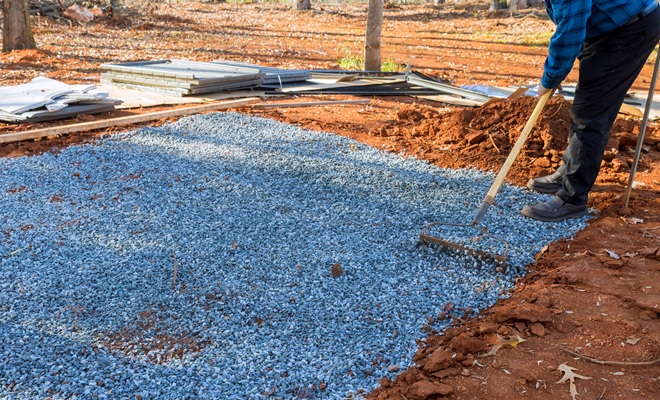
Utilities
An office building will need electricity. All the electrics will need to comply with Part P of the building regulations, which means you will need a qualified electrician to do the work. If you want to avoid a building inspection, then it is best to use an electrician who is part of the Competent Person’s Scheme. This means they are approved to self-certify their work, which will save you building control fees.
Building control fees vary between local authorities. However, the average cost for an electrical survey and the issue of an EICR certificate is between £120 and £300 in 2025.
The average costs to install a consumer unit in your garden office and connect it to your mains electricity will be between £650 and £840 for the consumer unit and the installation costs of around 4-5 hours.
You will also need an internet connection. You could use the WIFI from your home by installing a WIFI extender, which will cost around £30. Another solution is to set up a mesh system, which costs around £100 per node. You can also use an Ethernet cable, which is the cheapest option at around £10.
The most expensive solution is to install point-to-point WIFI, which will require professional installation and could cost between £200 and £450.
If you decide to have a water supply in your garden office, you will need a plumber to connect the water from the mains connection in your home. You may also need to lay new pipework in the garden. The plumbing work would depend on what you have installed, but the costs are likely to range from £500 to £2,000.
Insulation and Heating
A 10m2 garden office will cost around £300 for floor insulation, which on average costs between £5 and £25 per m2.
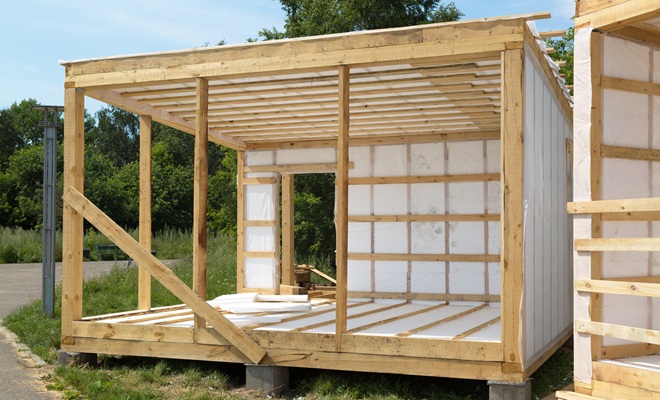
There are a variety of heating options available. You could have an air conditioning unit installed for heating and cooling, which will cost between £650 and £2,000. Underfloor heating installation is another option and will cost around £800. Otherwise, you could use a portable heater, which costs on average between £15 and £200.
Planning Permission (if you need it)
Planning permission and building regulations will not normally apply to the construction of a garden office as long as the building is less than 15m2 and doesn’t contain sleeping accommodation. It must also be 2m away from the boundary of your property.
However, if you live in a conservation area, in a listed building, or you want the garden office to be within 2m of your property line, then you will need planning permission, and the cost for a planning application is currently £262.
Building regulations will apply if you have a toilet installed in your garden office because of building standards for water and drainage.
Landscaping and Creating a Path
To landscape your garden and create a pathway to your garden office, you will need to hire a landscape gardener. The cost will depend on the work, but is likely to cost between £12 and £120 per m2 for jobs like levelling and grass installation.
Building a path can cost between £60 and £90 per m2. The average day rate for a landscape gardener is between £200 and £240 a day or between £25 and £30 an hour.
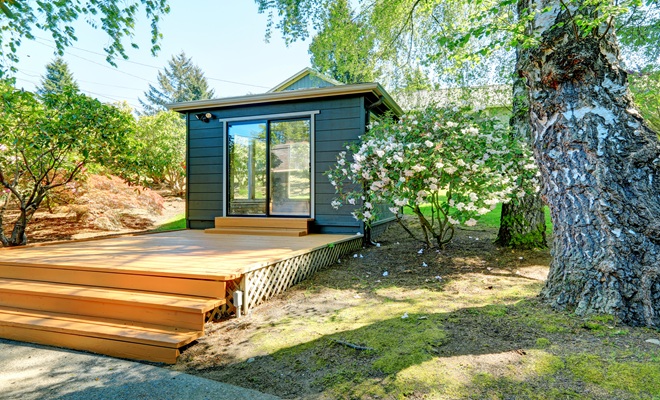
Security Features, Including Lighting and Alarms
Security lighting for the garden will depend on the type of lighting you choose and the number of lights you have installed. On average, security lighting ranges from £80 each to £500. The average cost to supply and fit a burglar alarm is around £450.
VAT on Labour and Materials
VAT on labour is normally 20%, but not all tradespeople are VAT registered, so VAT won’t be applicable in these cases. Materials are also charged at 20% except if they are energy efficient, such as insulation, solar panels and energy-efficient heating. In which case, the VAT is reduced to 5%.
Decoration
If you want to hire a painter to decorate your garden office, then you should expect to pay between £150 and £200 a day outside London and between £250 and £300 in the London area. On top of labour costs, you’ll need to add the cost of paint. Interior paint can cost between £10 and £50 for 5 litres. Exterior paint ranges from £5 to £150.

Furniture
The cost of fitting out your garden office will depend on the quality of the fittings you want to install. If you want to furnish it cheaply, then you can buy flat-packed furniture and hire a handyperson to assemble the pieces and put up any shelving.
A handyperson normally charges between £35 and £40 an hour. Fittings can range between £500 and £5,000 depending on your choices.
Cost Breakdown Calculator
Individual costs of installing a garden office: Total Cost: £16,000
Materials
£14,000
Labour
£1200
Utilities
£800
Labour Costs and Timeframes
The labour costs will depend on whether you have a bespoke garden office, a flat-packed DIY option or a modular building.
Modular buildings usually come with everything you need prepared. So, you are only likely to need a builder or labourer to prepare the foundations and an electrician to connect the electricity supply. Buildings with water will also need a plumber.
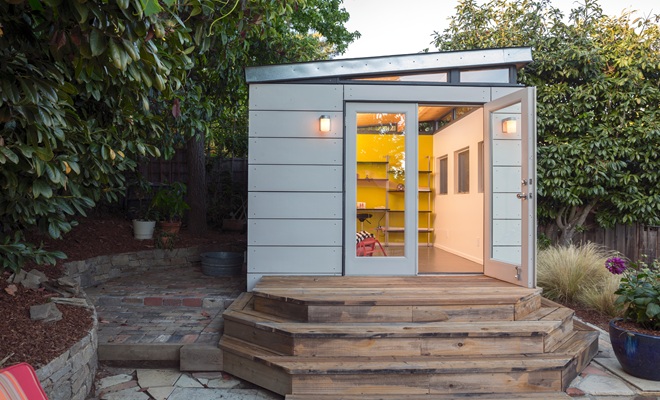
If you are going to install underfloor heating or an air conditioning unit, you may also need specialists for these jobs.
A bespoke garden office will need a carpenter or builder, insulation installers, an electrician, and a plumber (if you want water). You might also need a window installer to put in your windows and doors.
Other trades you might use if you don’t do the jobs yourself include a painter, a gardener and a handyperson to put up shelves and assemble flat-packed furniture.
Putting up the structure of your garden office will take between 1 and 7 days, depending on the size, location and complexity of the work. Modular garden offices often include installation within the cost of the building, or they offer the service at an extra cost.
If you hire an installer, then you are likely to pay between £275 and £325 a day. A small garden office will take 2 people, 1 to 2 days to install. Larger structures might need four people and take up to a week.
Have a look at this table to see the hourly and daily rates of the various trades you may need to use:
| Trade | Hourly Rate | Daily Rate |
|---|---|---|
| Carpenter | £16 - £40 | £128 - £320 |
| Builder | £16 - £42 | £128 - £336 |
| Electrician | £28 - £50 | £224 - £400 |
| Plumber | £27 - £80 | £216 - £640 |
| Labourer | £10 - £40 | £80 - £320 |
| Painter | £16 - £40 | £128 - £320 |
| Gardener | £12 - £59 | £96 - £472 |
| Handyperson | £35 - £40 | £280 - £320 |
| Heating Specialist | £20 - £30 | £160 - £240 |
| Air Con Installer | £150 - £200 | £1,200 - £1,600 |
| Window Fitter | £17 - £38 | £136 - £304 |
Types of Garden Office
Cedar Garden Office
Western cedar is a durable wood that’s used for cladding because of its resistance to insects and fungus. The wood is also an attractive red colour that can be enhanced and maintained with a coating of wood oil before the building is exposed to the sun’s UV rays.
Average cost for a medium-sized garden office of 12ft x 8ft - £17,500 to £22,000

Pros:
- ✔ Water repellent
- ✔ Fungus and insect resistant
- ✔ Long-lasting (25 years or more)
Cons:
- ✖ An expensive option
- ✖ Needs more maintenance than a composite or UPVC option
Pressure Treated Timber Garden Office
Wood that has been pressure-treated with a preservative solution, which is applied under high pressure to ensure it permeates throughout the entire piece of wood. The preservative then protects the wood from rot, decay and fungus. Treated timber is usually spruce or wood polymer composite, which is a mix of wood and plastic.
Average cost for a medium-sized garden office of 12ft x 8ft - £12,500 to £13,750
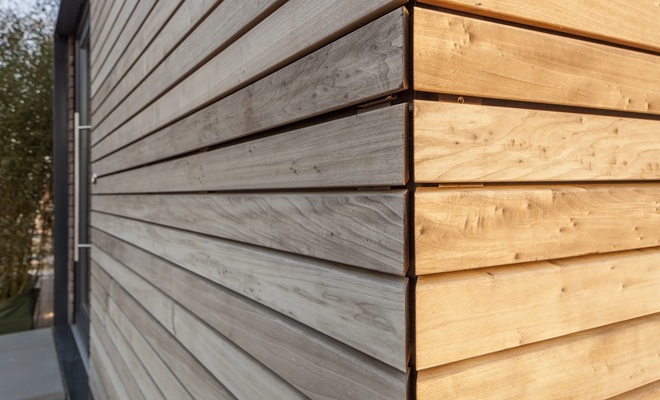
Pros:
- ✔ Ideal for outdoors (lasts between 20 and 25 years)
- ✔ Durable
- ✔ Cost-effective
Cons:
- ✖ Needs to be maintained and sealed
- ✖ Chemicals in the wood aren’t eco-friendly
Composite Garden Office
Composite is a popular choice of material because it won’t crack or splinter like wood, and it doesn’t need a lot of maintenance. It’s also ideal if you want a material that will last for decades.
Average cost for a medium-sized garden office of 12ft x 8ft - £17,000 to £18,250
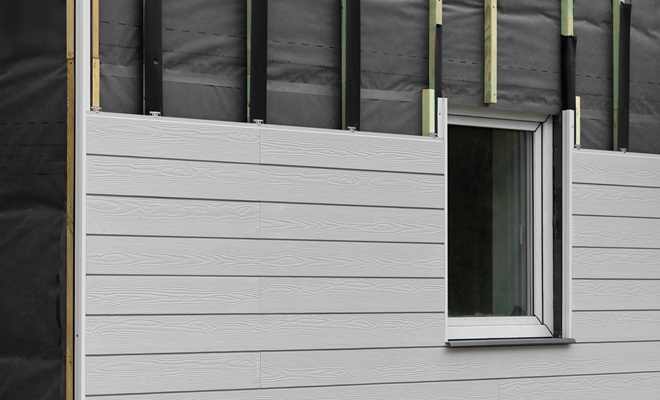
Pros:
- ✔ Easy to clean
- ✔ Low maintenance
- ✔ Durable (25 to 50 years)
Cons:
- ✖ More expensive than some other options
- ✖ Colour may fade over time
Thermowood Garden Office
Thermowood is a Scandinavian softwood that has been heated to a high temperature to make it durable and resistant to fungus, rot, insect infestation and moisture. It often doesn’t require painting and over time will fade to a pale grey colour. Thermal modification also improves the insulation of wood.
Average cost for a medium-sized garden office of 12ft x 8ft - £17,500 to £18,750

Pros:
- ✔ Durable (30 years or more)
- ✔ Needs less maintenance than traditional wood
- ✔ Resistant to rot, decay and fungus
Cons:
- ✖ Might become susceptible to cracking over time
- ✖ More expensive than some other options
PVC-u Garden Office
PVC-u is a thermally efficient material that doesn’t need a lot of maintenance and is cheaper than wood. It’s also easy to install and long-lasting. It comes in a choice of colours and is ideal for outdoor use.
Average cost for a medium-sized garden office of 12ft x 8ft - £11,000 to £13,500

Pros:
- ✔ Affordable and durable (20 - 30 years)
- ✔ Low maintenance
- ✔ Resistant to rot and moisture
Cons:
- ✖ Isn’t a natural look like wood
- ✖ Colour may fade over time
DIY vs Professional Installation
Installing a small garden office is well within the capabilities of a competent DIY enthusiast.
Offices that come as flat-packed kits will normally contain all the materials you need to install the structure. If windows and doors are also included, then there isn’t much work you’ll need from a professional.
If you haven’t carried out any sort of installation project before, then we would recommend professional installation in order to avoid expensive mistakes.
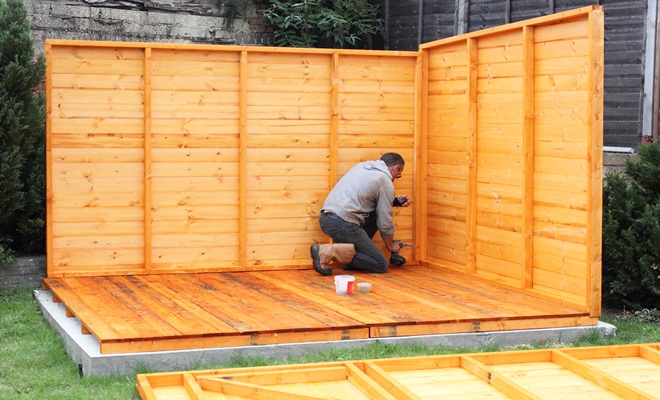
A professional installation will probably take less time than a DIY installation, and it will come with a warranty or guarantee.
Modular garden offices often include delivery and installation as part of the total cost, or some companies offer an installation service for an extra fee.
A garden office installation usually takes between 2 and 4 days and will involve more than one person. Labour costs will be, on average, between £275 and £325 a day.
Planning Permission and Regulations
If you don’t intend to use your garden office as a place to sleep, then you won’t need planning permission as long as you comply with the regulations for installing a garden room.
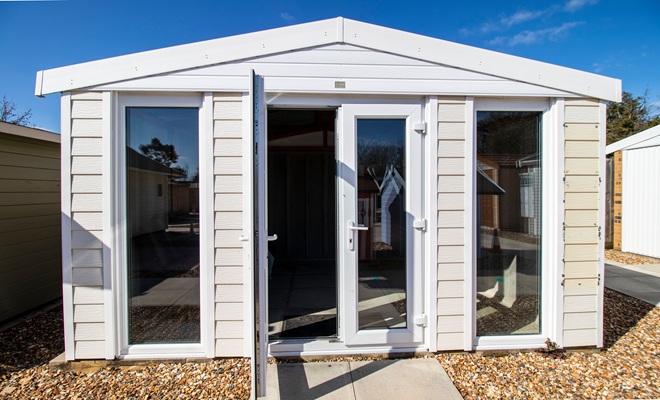
A permitted development will allow you to build a garden room without planning permission as long as:
- The garden room isn’t in front of your home
- You are not taking up more than 50% of your garden
- The building is single-storey and no more than 3 metres high (or 4 metres with a dual-pitched roof)
- The eaves don’t go more than 25 metres above ground level
- There isn’t a raised platform, balcony or veranda
- It is not being used as a living accommodation
However, if you live in an area of natural beauty, a conservation area or in a listed building, then the rules of permitted development won’t apply, and you will need permission from your local planning department. The cost of a planning permission application is £262.
Cost of Removing or Upgrading a Home Office
If you need to repair cladding on a garden office, then you are likely to pay between £20 and £40 an hour for a tradesperson. Cracks, for example, can be filled, and damaged panels can usually be replaced. Upgrades to a garden office can include a new roof, up-to-date cladding and a new coat of paint.
Roofing material costs between £10 and £70 per m2, depending on the amount and the type of material you need.
Cladding costs will also depend on the material. You should expect to pay between £15 and £60 per m2.
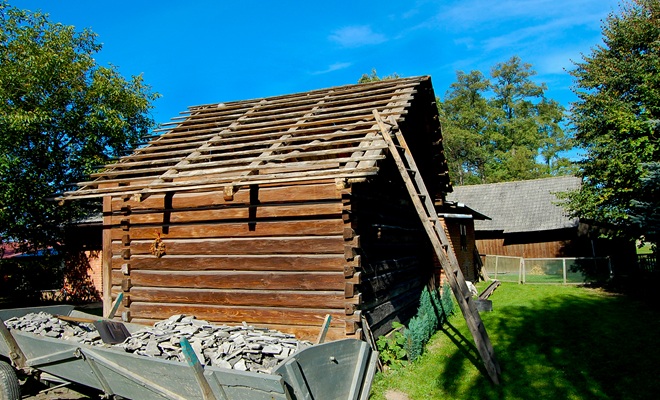
The cost to paint a garden office will depend on the size of the structure and the quality of the paint you choose. On average, it will cost between £200 and £600.
Removing a home office will cost on average between £500 and £1000, as long as it is a straightforward job. This price may or may not include skip hire to dispose of the old material. If you need to hire a skip, then you’ll be looking at between £150 and £200.
FAQs
Finding and Hiring a Professional Garden Office Installation Specialist
When you want to hire tradespeople to work on your garden office, start by asking for recommendations from family and friends. Otherwise, use the internet and use online directories like PriceYourJob to find reliable contractors.
Always get at least 3 quotes so you can compare prices, and when you speak to the contractor, ask the following questions:
- Are you a member of a trade association? Electricians may be registered with NICEIC, and plumbers could belong to CIPHE.
- Do you have insurance? (All trades should have public liability insurance as a minimum.)
- Do you have a website or portfolio I could look at?
- Does your work include a guarantee?
- Have you done this type of work before?
- What qualifications and accreditations do you have?
- When can you start, and how long do you estimate that the job will take?
Make sure all your quotations are in writing, either delivered to you on paper or by email.









